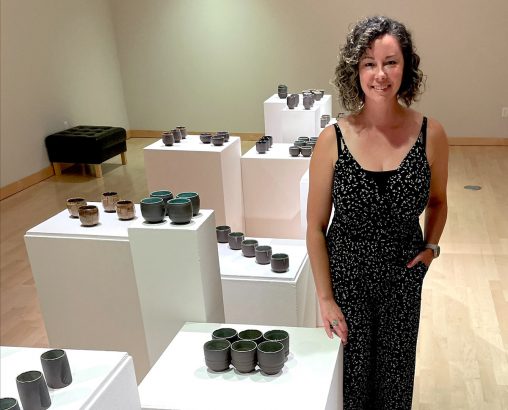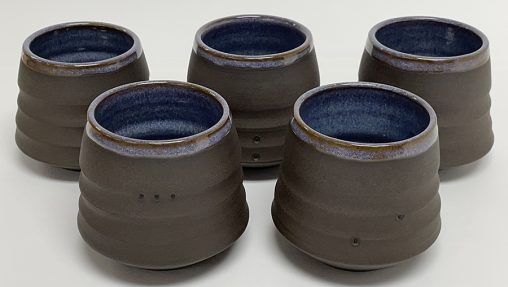
As a student in Wright State’s Master of Humanities Program, Bethany Lamb researched how cups represented their cultures throughout history and produced her own ceramic cups for an exhibition in the Stein Galleries.
A ceramic cup may be a simple, utilitarian object, but for 2022 Wright State University graduate Bethany Lamb, it provides deep insight into other people and their culture.
As a student in Wright State’s Master of Humanities Program, Lamb researched and produced an essay on historical examples of cups and the ways that they represented their cultures.
Lamb, who graduated from the College of Liberal Arts at the end of the Summer Semester, also produced her own ceramic cups for an exhibition in the Robert and Elaine Stein Galleries in the Creative Arts Center.
The exhibition’s title, “Heirlooms,” was a reference to the way ceramic cups are inherited material culture. A cup’s form, texture and size are influenced by societies’ priorities and customs that are passed down from century to century, Lamb said.
“Just like heirlooms kept by a family, cups have the same ability to retain intention and meaning of communities and traditions,” she said. “Studying the ways cups are made and why provides a deeper understanding of the people that use them.”
Ceramicists leave behind physical heirlooms of material methods with which people in their culture interact, she said.
“Those picking them up have the potential to observe and use that intention,” she said.
The cups that Lamb created for the exhibition are reminiscent of smaller forms used in China during the second to the fifth century B.C. Decorated simply with mostly bare clay on the surface, the cups are meant to connect the user to the true nature of the material.
“The purpose of the smaller form is to encourage moderation and intentional agency,” Lamb said. “My hope is to encourage people to take a moment of pause when using a cup to think about where and why it is the way it is. In what ways has historical human material engagement changed the shapes of drinking vessels being used.”
Lamb, who is from Lebanon, Ohio, earned a Bachelor of Fine Arts in Photography and a Bachelor of Arts in Art Education from Eastern Kentucky University.
She teaches photography, 3D/ceramics, drawing and AP studio art for grades nine through 12 at Waynesville High School.
She has also been throwing since high school and has a lot of experience making cups. She periodically sells her ceramic work through my ceramics Instagram @bisonceramics.
“My thesis, however, did push me to see my work in a new way and approach ceramics as fine arts connected to historical forms,” she said.
She also operates her own photography business, Bethany Nicole Photography, which specializes in weddings and portraits and is available on Instagram @b.n.photo.

Bethany Lamb’s cups are reminiscent of smaller forms used in China during the second to the fifth century B.C.
Lamb was drawn to Wright State’s Master of Humanities program after taking a humanities course as an undergraduate student that she loved. She also wanted to pursue a degree that was different from her undergraduate degrees but would still support her work as a teacher and artist.
“As a teacher, I love people and so studying the origins of cultures and communities and how those things are affecting today’s world was interesting to me,” she said.
Provided by the College of Liberal Arts, the Master of Humanities program offers a unique, flexible, interdisciplinary opportunity for graduate study. In consultation with the program’s director, students design their own integrated individualized program of study based on their interests.
Lamb received individualized attention for her thesis and goals from faculty members who were invested in her work. She learned how to research, record and write, she said, so that “I could join in on conversations about things I am passionate about.”
“The program also offered lots of flexibility and customization of courses I could take,” Lamb said. “This let me fashion my classes around what I wanted to research.”

 Wright State psychology team studies ways to identify fatigue in pilots, drivers
Wright State psychology team studies ways to identify fatigue in pilots, drivers  Wright State videographer Kris Sproles wins Regional Emmy and Ohio journalism award
Wright State videographer Kris Sproles wins Regional Emmy and Ohio journalism award  Wright State Boonshoft School of Medicine ranked among the nation’s best for 2024 by U.S. News
Wright State Boonshoft School of Medicine ranked among the nation’s best for 2024 by U.S. News  Exposing biotechnology
Exposing biotechnology  Wright State faculty member Dan Noel uses unique background to inspire new leaders
Wright State faculty member Dan Noel uses unique background to inspire new leaders 